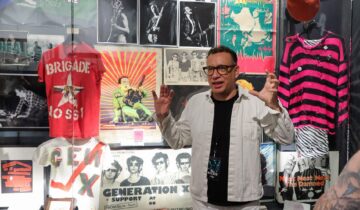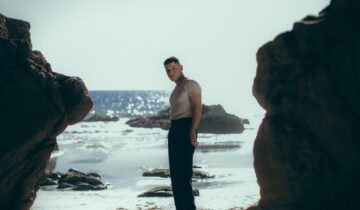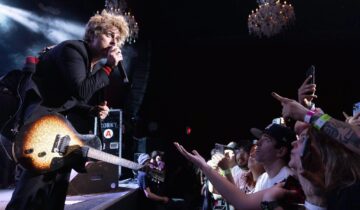 For the Economist: JOURNALISTS often lament the death of the physical album at the hands of music streaming services. Why bother to buy a CD, a vinyl record, or even a full-length digital download when songs can be selected one-by-one, or curated by a service like Apple Radio, often free of charge? Adele’s latest album, “25”, sold 5.98m copies in its first month but was not available on major streaming services such as Apple Music and Spotify. By comparison, Red Hot Chili Peppers’ fifth studio album “Blood Sugar Sex Magik” sold 13m copies in 1991.
For the Economist: JOURNALISTS often lament the death of the physical album at the hands of music streaming services. Why bother to buy a CD, a vinyl record, or even a full-length digital download when songs can be selected one-by-one, or curated by a service like Apple Radio, often free of charge? Adele’s latest album, “25”, sold 5.98m copies in its first month but was not available on major streaming services such as Apple Music and Spotify. By comparison, Red Hot Chili Peppers’ fifth studio album “Blood Sugar Sex Magik” sold 13m copies in 1991.
Yet musicians from all corners of the industry—mainstream, middle-tier, independent, up-and-coming—continue to create albums. They are artistic statements, and build a body of work that artists can not only be proud of, but build tours around. Spotify suggests that albums are still worth artists’ while on a fiscal level, even though they pay rights holders a seemingly measly sum of $0.006 and $0.0084 per stream. In 2013, they estimated that monthly royalties for a niche indie album were more than $3,000, $17,000 for a rock album, and $145,000 for a top-ten album. Global breakthrough albums could reap around $400,000.
Fans who prefer full, cohesive albums to hit singles are significantly fewer, but they still exist. Often over 30 and nostalgic, they like to have something to hold and look at, as well as to listen to. Benji Rogers, CEO of the PledgeMusic crowdfunding platform, argues that the album is “still valid for many people. The concept of belonging to a ‘tribe’ is still valid. Super fans buy to remember something they were there for. They want to say, ‘I was there, I was part of that when only a few were.’” “There”, in this sense, can mean not just a live show, but a moment in a band’s career captured by an album.
These ‘tribes’ are loyal, and willing to dip into their pockets to support the bands they love; the last three albums of Jubilee Riots, a Canadian rock band, have been crowdfunded, with some recent songs based on story submissions from followers. Last spring, fans pledged funds online to help Megadeth, an American thrash metal band, complete their 15th album. They were rewarded with guitar lessons from the band, and invitations to the studio recording sessions.
Clearly, musicians today can harness the power of the internet to their albums’ advantage. We Are The City, a Vancouver-based progressive-rock trio, used live-streaming through their website to engage fans, and create momentum ahead of the release of their third album. The entire recording session was broadcast, over three and a half weeks. Everything that happened in the studio—the band playing their instruments, standing around, falling asleep—was accessible to their admirers via their website. Between five and 20 people watched the feed at any given time, with up to 100 viewers at one point.
Members of the band have no specific evidence that their experiment led directly to increased sales, but note that they had to order more copies halfway through their European tour this winter. They are adamant that money wasn’t the goal. For Andy Huculiak, the drummer, the experiment was “about finding new ways to explore social media and turn it into a medium of expression…the same with a painting, or films, it’s sort of like social art in real time.” David Menzel, the guitarist, says that the stream “was a success because we did it and enjoyed it…as far as selling records, or thinking like the industry, no one cares about that stuff. How our album does is totally relative. Are you looking at it from what Drake does, or small indie bands from Canada?”
They have a point: sales and recognition are only roughly correlated. The debut album of Alabama Shakes, an American rock band, sold less than 800,000 copies, yet earned three Grammy nominations and international attention. Their 2015 album, “Sound and Color” is nominated for four awards again this year. Arcade Fire, a Canadian indie-rock group, has been nominated for numerous Grammys, won a Grammy, racked up Brit awards and Juno awards, and performed in New York’s Central Park with David Bowie and at huge festivals like Coachella: all benchmarks of critical success. Yet their top-selling album “The Suburbs” sold 765,000 copies in America and only 343,000 in Britain.
All this considered, Mr Rogers remains conflicted about the future of full-length albums. “[They’re] still valid for a certain age group of fan, but eventually they may be nonsensical. When my daughter who is now four turns ten, it won’t be valid.” Perhaps, but the future of albums will not likely be determined by ten-year-olds, says Ryan Chisholm, who signs acts for Nettwerk Music Group, an independent record label in Los Angeles. He is more optimistic: “We have album artists, and we run marathons with those clients.” His bet is that when those 10-year-olds are 30, enough of them will want to run those marathons alongside.



